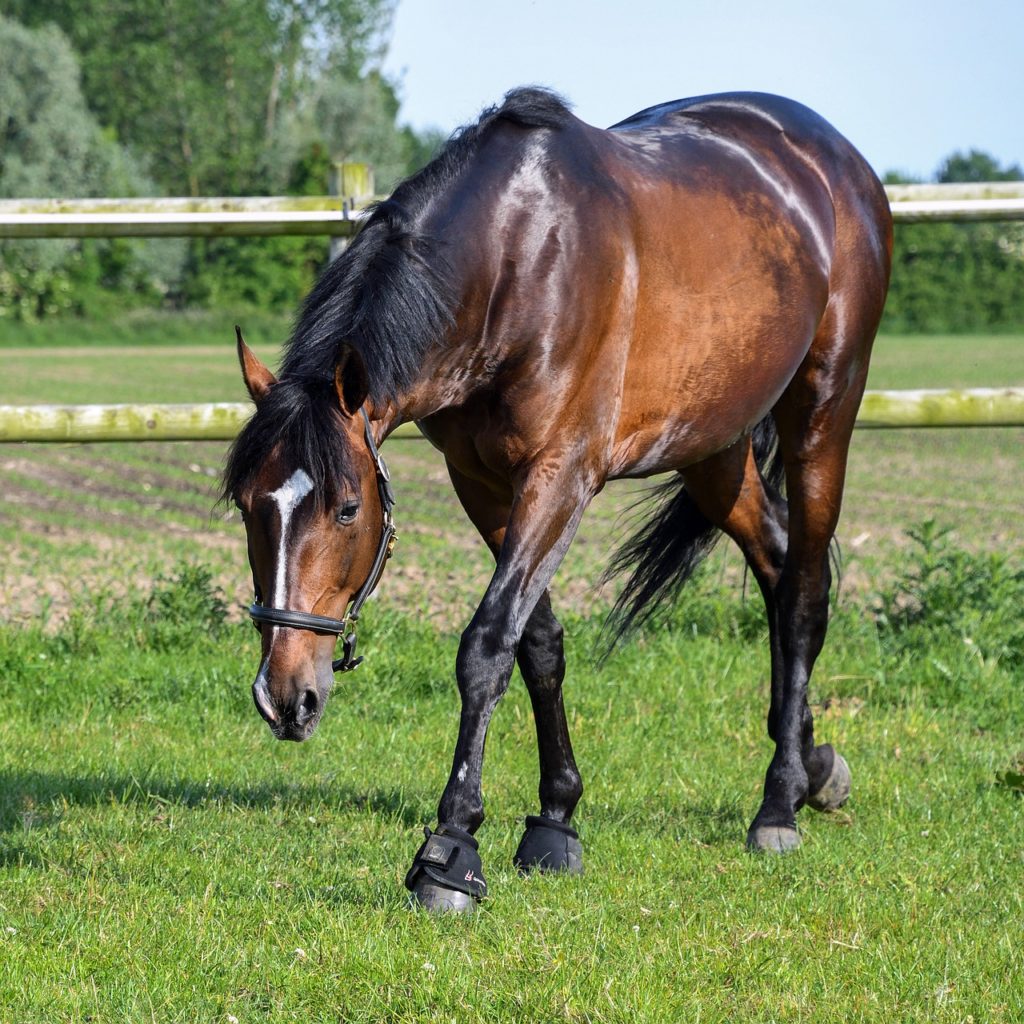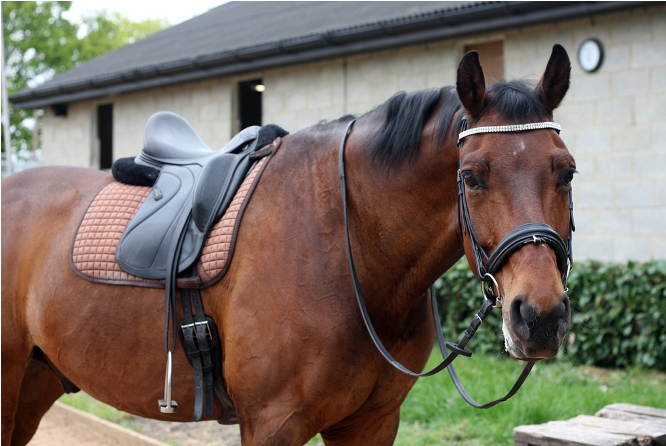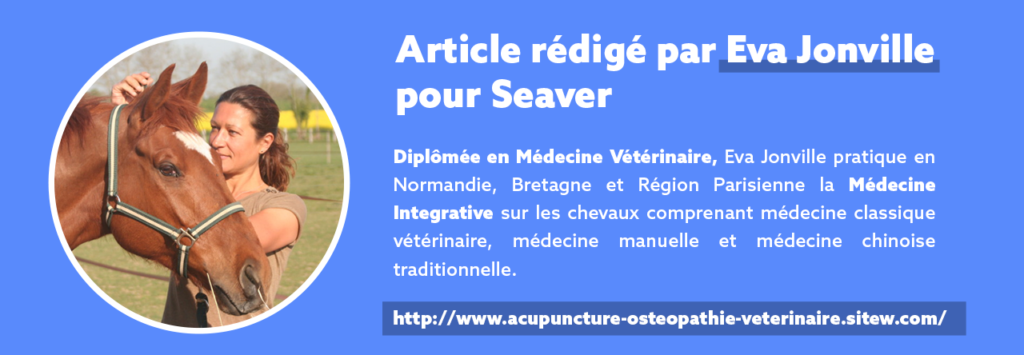Thursday, June 25, 2020
Not all horses are equal when it comes to muscle tone. Some stay fit and toned with just two work sessions a week, while others need to be worked every day. With no more than one or two rest days a week to maintain a musculature that meets their sporting requirements. The case of Marbuzet, described below, is indicative of a horse in the second situation. For him, therefore, the 6 weeks of confinement have not been profitable and this horse lacks tone!
Find out more about this consultation and solutions to Marbuzet's locomotor problems in this article.
The following article was written by Dr. Eva Jonville. For a better understanding of its meaning, the paragraph below explains how she carries out her consultations:
"Acupuncture is part of my primary approach and plays a central role in my consultations. They are built on a foundation of Traditional Chinese Medicine. I then use osteopathy or manual medicine, in a synergistic and complementary way. This is useful for removing musculoskeletal structural fixations when necessary.
Finally, depending on the disorders encountered, after an induction session using acupuncture needles, I can suggest a course of treatment using Chinese pharmacopoeia. This prolongs the effects of the needles over time, avoiding the need for frequent consultations.
Diagnosis is therefore carried out and refined according to 3 reading grids:

The joint use of all these techniques potentiates each other for maximum results, the aim being to offer horses an integrative medicine ensuring complete, complementary and coherent care.
Having said that, there's no such thing as a standard consultation: each horse guides me towards its own needs, which I limit so as not to upset the balance or dynamics in place. It's all about being succinct and precise in the choice of information given to the body and the technique(s) employed.
In this way, the choice of treatment method is based on a precise individualized diagnosis and in-depth knowledge of therapeutic techniques, crowned by a continually nourished and enriched experience."
Marbuzet, a 7-year-old gelding, perfectly meets his owner's expectations. He regularly takes part in show-jumping competitions. He also works hard on the flat and loves the outdoors. That said, he's a horse whose muscles need regular work to stay toned. 10 days in the pasture and his back goes to pieces. When you return to work after a period of rest, you must insist on stretching him so that he raises his back and contracts his abdominal muscles. His lateral movements are less satisfactory, and when jumping obstacles he gets closer to the bars and often makes "little feet". But now, after 6 weeks of confinement in the meadow, his owner fears that he has hurt himself or is suffering from osteoarthritis (although there were no signs prior to confinement) as his hind legs are " very stiff ".

In fact, Marbuzet shows a bending defect and instability of the stifles:
Because Marbuzet didn't just lose his back and abs during this rest period, he also lost overall muscle mass and tone. The muscular slings that consolidate his joints are less effective, making him more unstable and uncertain in his movements. The quadriceps femoris in particular is lacking in its role of traction on the patella, and no longer compensates for a probable laxity of the medial patellar ligament. When the stifle is flexed, the patella has difficulty "unhooking" from the femoral tubercle. This is known as partial patellar hooking.
Rq: contraction of the quadriceps femoris causes the patella to externally rotate and thus "unhook" from the femoral tubercle.

Conservative treatment is to be preferred and is gradual in its implementation:
First of all, restore muscle tone, particularly that of the quadriceps femoris, with exercises on the flat such as stepping from bars to the ground, two-track work, transitions and uneven surfaces. Acupuncture can be very useful in restoring balance to the joint and tension to the medial patellar ligament.
As a second line of defence, if these measures are not sufficient after a few weeks, local injections can be made into the medial patellar ligament and/or an acupuncture point on the inside of the stifle can be stimulated. Farriery can also be adapted.
The critical stage, not described by Marbuzet, is persistent or intermittent but recurrentpatella clinging. The latter is characterized by the pathognomonic appearance of a leg locked in extension, with the foot rubbing in a pincer movement. In this case, backing up is usually enough to unblock the kneecap, but if not, manipulation of the kneecap itself is necessary. If the horse limps as a result of this persistent patellar impingement, treatment with NSAIDs (non-steroidal anti-inflammatory drugs) is instituted. In recurrent cases, if conservative treatment proves insufficient, surgical treatment may be considered.

But today, after 6 weeks of ground bars at walk pace in addition to his usual activity, adapted farriery and a few acupuncture needles, Marbuzet is back to long jumping options and tackling downhill runs with a frank and confident stride outdoors!
To compensate for this locomotion defect and gradually restore muscle tone, it is therefore advisable to perform, over several training sessions, exercises favoring floor bars犀利士 step, two-track work and transitions.
The Seaver exercise catalog offers a vast choice of exercises in a number of disciplines, easily adaptable to the rider's facilities. Each exercise is accompanied by one or more explanatory diagrams, detailed instructions and tips.
In this case, two exercises in particular can help improve the horse's physical condition.

This exercise, which requires 5 or 6 bars on the ground, has several advantages. It encourages the horse to take charge, pay attention and maintain a minimum level of tone. To perform this exercise correctly, you need to ensure that the horse's impulsion and straightness are maintained.

This second exercise, also based on ground bars, nevertheless incorporates transitions into its steps. It will help you gain control and confidence, and encourage your horse to remain attentive. On your first passage through the device, make a transition from walk to trot before crossing the last bar. Return to the device at trot after performing a volte; then transition from trot to walk before the last bar on the ground and your exit from the device. Once you've done this correctly, you can vary your transitions and bring them closer together.
Given that the idea is to pass the bars on the ground at a walk to force the horse to flex the stifles and thus tone up the femoral quadriceps, just like the lateralization and medialization exercises for the hind legs, you can, on the voltes, alternate hips in/out, which allows you to work on straightness on the bars and two tracks in the figures.
These two exercises and all the team' s explanations and advice are available free of charge on theSeaver app.
Marbuzet is not an isolated case, especially after this period of confinement. This is a case of a constitution associated with a particular anatomical conformation that can be found in all breeds: the horse's "weak spleen" constitution in Traditional Chinese Medicine, with a non-optimal function for assimilating and using nutrients, resulting in a lack of muscle tone, among other things; and an open stifle joint conformation with laxity of the medial patellar ligament. There is no joint fixation or injury of any kind in the case described above, and the return to normal locomotion is achieved with the rider's active participation. That said, the outcome depends onthe accuracy and relevance of the diagnosis, as the resulting treatment can be radically different for clinical signs that are quite similar from the rider's point of view.
We hope you enjoyed this article!
See you soon for another article,
Dr Eva Jonville
